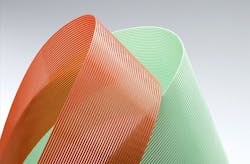Rugged ribbon cable for military communications, avionics, and industrial uses introduced by Molex
Unlike polyvinyl chloride (PVC) and thermoplastic elastomers (TPE) products, The Molex extruded FEP dielectric insulation material can withstand exposure to chemicals, extreme temperatures, abrasions, and flexure, company officials say.
Temp-Flex FEP flat-ribbon cables are durable in temperatures ranging from -65 to 200 degrees Celsius and they resist acids, alcohols, aldehydes, bases, esters, hydrocarbons (aliphatic, aromatic, and halogenated), ketones, and oxidizing agents.
An extruded cable encapsulates each conductor with insulation that will not delaminate, while the low-loss dielectric constant (2.1) ensures the optimum signal transmission with minimal loss. The cables can be mass terminated using a conventional insulation displacement termination/connector (IDT/IDC) technology.
"Temp-Flex FEP cables were specifically designed for the most severe environments," says Jeet Sanyal, the Molex engineering manager. "They remain extremely flexible, making them for today's smaller more rugged applications including flight data recorder boxes, missile systems and robotics found in manufacturing plants across several industries."
For more information contact Molex online at www.molex.com.
